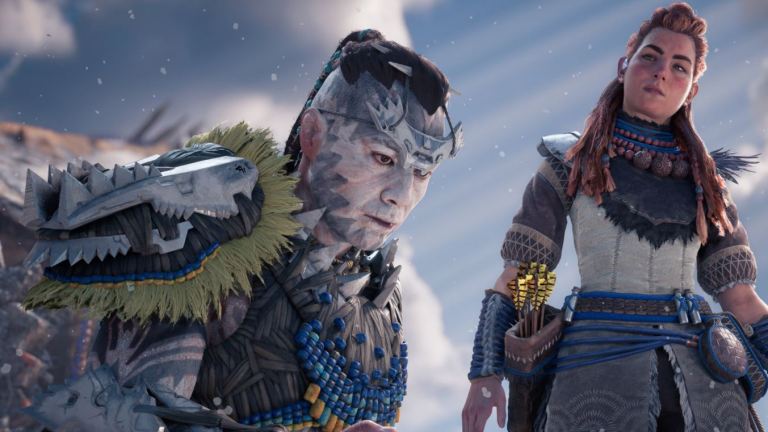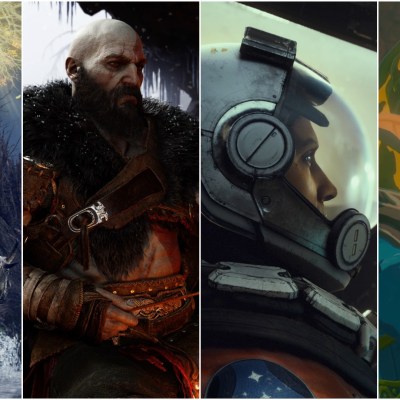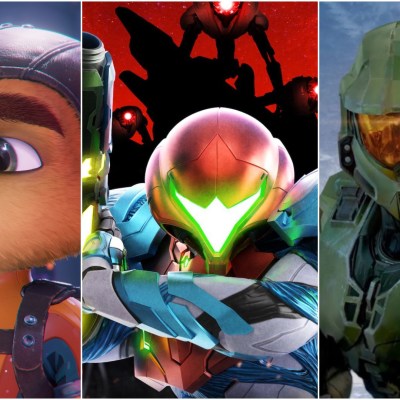Horizon Forbidden West Shows That Following the “Formula” Isn’t Always Bad
Horizon Forbidden West reminds us that you don't have to start a revolution to be great.

After five long years (and one exceptional piece of DLC), Horizon Forbidden West (the sequel to 2017’s Horizon Zero Dawn) is finally here. While many PlayStation fans who have been patiently waiting for this game will find an experience that justifies the wait, the one thing they won’t find is a game that feels substantially different from its predecessor or even some other open-world titles released in recent years.
Indeed, even some of the most positive reviews of Horizon Forbidden West take a little time to offer a disclaimer that those expecting a substantially different experience from Zero Dawn may be surprised to find that after five years and the introduction of a new generation of console hardware, Forbidden West still feels surprisingly similar to Zero Dawn in many ways. That revelation has inspired some to call Forbidden West “formulaic” and even suggest that it’s not the game we should have gotten after all this time.
Whether or not you believe that’s the case is obviously up to you, but the conversation about Forbidden West‘s familiarity offers a fascinating chance to look at what we really mean when we accuse a game of sticking to a formula and when there are times when that adherence to what came before is a necessary part of the evolution of gaming that often says little about the quality of an experience.
Horizon Forbidden West Probably Won’t Win Many New Fans
Recommending whether or not you should play Horizon Forbidden West isn’t quite as simple as saying “let your love of the first game be your guide,” but that’s certainly a good place to start.
It’s not exactly unheard of for a video game sequel to court fans who were largely uninterested in the previous game (Grand Theft Auto 3, Uncharted 2, Fallout 3, Team Fortress 2, and many more follow-ups all attracted wider audiences than their predecessors), but those instances are typically reserved for games and franchises that were either just missing that little something or games and franchises that greatly benefited from the introduction of new technology.
Well, considering that Horizon Zero Dawn has reportedly now sold over 20 million copies, it’s not like this series really needed to change all that much to reach a significantly wider audience. Given the current shortage of next-gen consoles and development complications caused by the Covid-19 pandemic, it’s also not like Guerrilla Games was in a position to make this a true PS5 exclusive built from the ground up to take advantage of that hardware. From a business standpoint, it makes all the sense in the world that Forbidden West sticks fairly close to its predecessor in terms of most of its basic design decisions.
However, there have been people (including fans of the original game) who have spent the five years since Zero Dawn’s release asking for changes. While some of those changes amounted to little more than relatively minor QOL improvements (we’ll get to those in a bit), others hoped an eventual Zero Dawn sequel might break free of its checklist-based, Ubisoft-style open-world shackles and fully embrace some of the concepts that set it apart (such as its hunting systems, unique mythology, and wonderful characters). There was an idea that Horizon Zero Dawn may be a kind of test run for the new franchise and that Forbidden West would really lean into what really makes this series stand out.
That expectation is certainly part of the reason why some of Forbidden West’s most notable shortcomings feel as significant as they sometimes do.
Horizon Forbidden West Sometimes Struggles to “Go Bigger”
“Bigger” has long been the guiding light of many sequels (especially video game sequels in the open-world era), and Forbidden West certainly won’t disappoint so far as that basic expectation goes. It offers a significantly bigger world filled with more characters, more enemies, more mechanics, and more story.
“More story” doesn’t necessarily translate to “better story,” though. Much like Zero Dawn, Forbidden West’s greatest narrative strengths are the quality of its world and mythology. Some of the best storytelling moments in the game happen when you take a little time to look around and really think about how and why this somewhat primitive world was built upon the ashes of a high-tech “advanced” society. To its credit, the game also does a pretty good job of expanding both our understanding of the world that was and our appreciation of the world that is via sequences that often blend the two concepts and use them to enhance each other.
The problem is that Forbidden West spends a bit too much time letting a small army of side characters spout what sometimes feels like an endless amount of exposition. There are fantastic side characters and sidequests in this game, but Forbidden West’s reliance on extended dialog sequences starts to wear you down relatively early into this massive adventure. There are times when you’ll find yourself wishing that Guerrilla Games had simply recognized how impressive the world they created was and found ways to let that world and the characters in it do the heavy living rather than those extended dialog sequences that seem determined to tell you absolutely everything. Besides, the answers are rarely as good as the questions.
Whenever I found myself waiting for yet another expository dialog sequence to end or debating whether it’s worth engaging with another sidequest that may just pile onto the core story elements I was truly invested in, I started to sympathize a little more with those cries for Forbidden West to do things differently. The game’s occasional struggles to stretch this franchise’s best qualities across a larger world were sometimes substantial enough to make me wonder what a version of this game unburdened by the “icon-based” expectations or modern open-world design (or one that embraced a minimalist approach) would have looked like.
Before you try too hard to separate Horizon from the familiarity of its open-world design, though, it’s important to take a little time to appreciate a few of the many ways that this game does clearly respect and learn from its predecessors’ most notable missteps.
Horizon Forbidden West Realizes Zero Dawn’s Potential
So far as its moment-to-moment gameplay goes, there’s very little doubt that Horizon Forbidden West is a better game than Zero Dawn.
Zero Dawn’s already compelling “hunting” combat system (which often tasked you with taking down massive robotic creatures while scavenging for invaluable supplies used to make traps, medicine, and other vital resources) is made that much better in Forbidden West thanks to the intelligent additions of an expanded “stash” system that eliminates so much of the frustration of needing to constantly gather and manage resources.
Meanwhile, Aloy’s new traps and significantly more useful spear skills mean that there are more times when you feel truly free to approach the game’s combat and hunting sequences the way you want to approach them. There’s often still a “best” way to do things, but that way isn’t always so obvious that it makes every other way to approach a situation feel pointless.
Those new combat features are nice, but there is little doubt that Forbidden West’s best improvements are found in the game’s greatly expanded navigation mechanics.
Getting around in Forbidden West still isn’t quite as enjoyable as it is in games like Marvel’s Spider-Man, Mad Max, and Assassin’s Creed where your movements and open-world traversal are an integral part of the open-world experience, but Aloy’s ability to dive underwater, glide, climb more surfaces more efficiently, utilize a hook shot and, yes, eventually fly mean that getting from one place to another no longer feels like this laborious task meant to kill time between the moments that really matter. Being able to find your way around this world in so many more ways is one of the things that helps you appreciate it that much more.
Mind you, there are still gameplay aspects of Forbidden West that simply do not work as well as they should, and some of those problems are “borrowed” from the original game. On-the-fly inventory management is still a cumbersome process that requires you to learn to love a series of menus and hotkeys, too many platforming sequences make it too obvious where you can and can’t go (even if you choose the “minimal UI” experience), and Aloy’s expanded skill tree features a few too many filler abilities that don’t always make leveling up feel like the rewarding experience it should be. Interestingly, many of those flaws bring us back to the idea that Forbidden West sometimes feels burdened by the expectations for it to be a bigger open-world game whether or not its developers were really ready to expand the original game in a way that made it feel like significantly more than more of the same.
However, there are other, much more important aspects of Forbidden West’s open-world design that make it easy to appreciate that Guerrilla Games knew exactly what they were doing with this game.
Horizon Forbidden West Uses the Expectations of Its “Formula” to Surprise You
For as often as I found myself groaning whenever I looked at a map full of objectives in Forbidden West and started to see its world as entries on a checklist bound by exposition, there were many more times I was taken back by the beauty of a setting I didn’t necessarily have to see, the thrill of a battle I didn’t necessarily have to fight, or the excitement that came from a discovery I could have just as easily missed.
That’s the funny thing about Forbidden West’s “familiarity.” The temptation to expect the game to offer something a little different due to both the time since Zero Dawn’s release and the number of open-world games built around a somewhat similar concept that we’ve seen over the last 15 years or so is understandable, but moment-to-moment, there are relatively few times when this game feels anywhere close to “complacent.”
In fact, whenever I found myself feeling a bit complacent in Forbidden West’s world, the game usually found a way to surprise me with some revelation or sequence that I either simply did not see coming or couldn’t wait to experience. That isn’t to say that the developers somehow manufactured those moments of complacency to heighten the excitement, but rather that Guerrilla Games excels at recognizing what parts of these kinds of open-world games fundamentally work and how those design elements allow them to do some fascinating things that both betray that sense of familiarity while embracing it in such a way that makes returning to this world feel oddly comforting despite the fact that it’s throwing so much at you.
For all the talk about Forbidden West following a formula, it’s pretty clear that nobody was more eager to reexamine that formula than Guerrilla. They realized they didn’t need to completely shake things up: they needed to take comfort in the things about Zero Dawn that clearly worked so they could focus their efforts on improving what didn’t and creating moments that are truly unique to this series and their vision for it.
Most importantly, Guerrilla Games uses Forbidden West to set themselves (and others) up for greatness.
Horizon Forbidden West Moves The Open-World Genre and This Franchise In the Right Direction
There are many ways that Horizon Forbidden West could be a better game, but the idea that its developers somehow took the “easy” road by staying true to Zero Dawn’s core concepts, as well as some of the concepts of the open-world genre, belittles the considerable effort that went into lovingly crafting the compelling characters, settings, and experiences that truly define this experience. It’s easy to get caught up in the familiar and forget that, in this instance, the familiar involves colorful vistas, sweeping scores, a small army of compelling characters, consistently engaging battles against mechanical monsters, and mythos that blend old-world customs with sci-fi concepts in a way we haven’t really from any other work of fiction.
Years after we’ve stopped comparing every platformer to Super Mario and every First-Person Shooter to Doom, too many people still seem tempted to reduce too many open-world titles to that magical “formula” they supposedly follow to the letter. While I understand the fatigue that comes with open-world games dominating the Triple-A landscape for the last 15 years or so (and I applaud games like Breath of the Wild and Elden Ring that challenge that genre’s conventions), focusing on the familiarity in Forbidden West is the surest way to blind yourself from the many qualities that separate the game from its competition and truly make it one of the year’s most impressive experiences and a more than worthy follow-up to the already impressive original.
Games like Forbidden West and Ghost of Tsushima belong to this new breed of open-world titles that don’t necessarily revolutionize the genre but rather find ways to make the entire concept feel fresh again by using that genre’s conventions to support ambitious artistic ideas that would crumble under their own weight if they weren’t supported by such a tested structure. Forbidden West sometimes sticks to a beaten path, but it goes further than so many other games in this genre and manages to plant a new signpost that I can only hope Guerrilla Games and other developers aspire to reach and surpass in the future.


